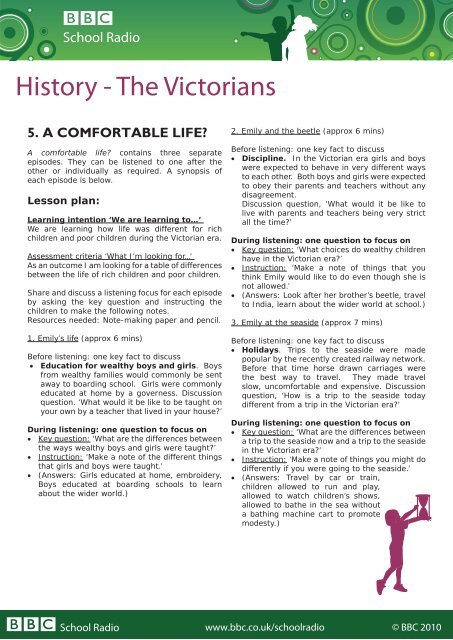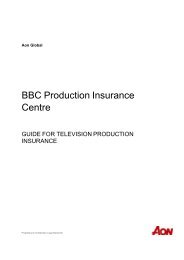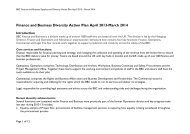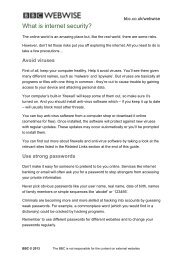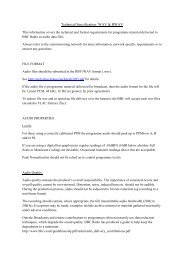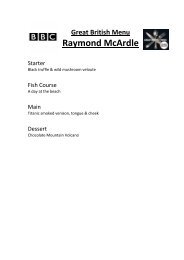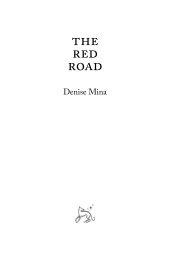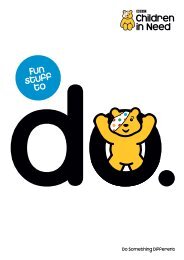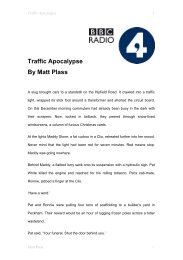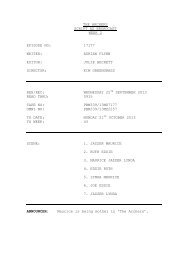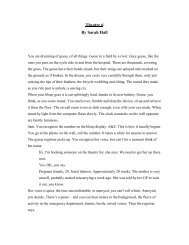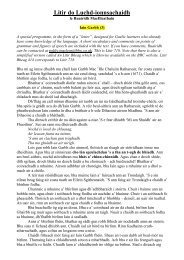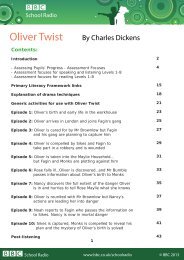History - The Victorians - BBC
History - The Victorians - BBC
History - The Victorians - BBC
Create successful ePaper yourself
Turn your PDF publications into a flip-book with our unique Google optimized e-Paper software.
School Radio<br />
<strong>History</strong> - <strong>The</strong> <strong>Victorians</strong><br />
5. A COMFORTABLE LIFE?<br />
A comfortable life? contains three separate<br />
episodes. <strong>The</strong>y can be listened to one after the<br />
other or individually as required. A synopsis of<br />
each episode is below.<br />
Lesson plan:<br />
Learning intention ‘We are learning to…’<br />
We are learning how life was different for rich<br />
children and poor children during the Victorian era.<br />
Assessment criteria ‘What I’m looking for…’<br />
As an outcome I am looking for a table of differences<br />
between the life of rich children and poor children.<br />
Share and discuss a listening focus for each episode<br />
by asking the key question and instructing the<br />
children to make the following notes.<br />
Resources needed: Note-making paper and pencil.<br />
1. Emily’s life (approx 6 mins)<br />
Before listening: one key fact to discuss<br />
Education for wealthy boys and girls. Boys<br />
from wealthy families would commonly be sent<br />
away to boarding school. Girls were commonly<br />
educated at home by a governess. Discussion<br />
question. ‘What would it be like to be taught on<br />
your own by a teacher that lived in your house?’<br />
During listening: one question to focus on<br />
Key question: ‘What are the differences between<br />
the ways wealthy boys and girls were taught?’<br />
Instruction: ‘Make a note of the different things<br />
that girls and boys were taught.’<br />
(Answers: Girls educated at home, embroidery,<br />
Boys educated at boarding schools to learn<br />
about the wider world.)<br />
2. Emily and the beetle (approx 6 mins)<br />
Before listening: one key fact to discuss<br />
Discipline. In the Victorian era girls and boys<br />
were expected to behave in very different ways<br />
to each other. Both boys and girls were expected<br />
to obey their parents and teachers without any<br />
disagreement.<br />
Discussion question, ‘What would it be like to<br />
live with parents and teachers being very strict<br />
all the time?’<br />
During listening: one question to focus on<br />
Key question: ‘What choices do wealthy children<br />
have in the Victorian era?’<br />
Instruction: ‘Make a note of things that you<br />
think Emily would like to do even though she is<br />
not allowed.’<br />
(Answers: Look after her brother’s beetle, travel<br />
to India, learn about the wider world at school.)<br />
3. Emily at the seaside (approx 7 mins)<br />
Before listening: one key fact to discuss<br />
Holidays. Trips to the seaside were made<br />
popular by the recently created railway network.<br />
Before that time horse drawn carriages were<br />
the best way to travel. <strong>The</strong>y made travel<br />
slow, uncomfortable and expensive. Discussion<br />
question, ‘How is a trip to the seaside today<br />
different from a trip in the Victorian era?’<br />
During listening: one question to focus on<br />
Key question: ‘What are the differences between<br />
a trip to the seaside now and a trip to the seaside<br />
in the Victorian era?’<br />
Instruction: ‘Make a note of things you might do<br />
differently if you were going to the seaside.’<br />
(Answers: Travel by car or train,<br />
children allowed to run and play,<br />
allowed to watch children’s shows,<br />
allowed to bathe in the sea without<br />
a bathing machine cart to promote<br />
modesty.)<br />
School Radio www.bbc.co.uk/schoolradio<br />
© <strong>BBC</strong> 2010
After listening – Follow up and<br />
extension activity:<br />
Activity: compare the lives of wealthy<br />
Victorian children with children today.<br />
Divide your page into two columns entitled<br />
Wealthy Victorian children and Modern children<br />
Write a few sentences in each column for each of<br />
these subheadings.<br />
Education for girls (Victorian: at home, arts<br />
and crafts. Modern: at school, all subjects.)<br />
Education for boys (Victorian: at boarding<br />
school, boys only. Modern: living at home,<br />
sharing school with girls.)<br />
Discipline (Victorian children: absolute<br />
obedience. Modern Children: using discussions<br />
to be fair and make agreements.)<br />
Day trips to the seaside. (Victorian: Train,<br />
walking and sitting only, bathing carts. Modern:<br />
Car or train, entertainment allowed, bathing and<br />
playing encouraged.)<br />
Differentiation and teacher support for S.E.N. /<br />
Focus group / Whole class<br />
Teacher to demonstrate on paper or a white board<br />
how to divide up the page and where to place<br />
subheadings. Sentence starters may be provided<br />
to support individuals, groups or the whole class.<br />
E.g. Wealthy Victorian children had to… Modern<br />
children are more likely to…<br />
Challenge for gifted and talented learners<br />
Under each subheading can you make a guess<br />
at why the people in Victorian times behaved so<br />
differently? You need to think about how technology<br />
has changed and how people feel about being seen<br />
having a good time.<br />
Plenary and Assessment<br />
In table groups or as a class, share and compare<br />
sentences written for each subheading. Are there<br />
any overall conclusions about differences between<br />
now and then? (Strictness, differences between<br />
boys and girls, modesty and dignity.)<br />
Planning and Curriculum Links:<br />
National Curriculum Programme of Study for<br />
<strong>History</strong> Key Stage 2:<br />
Knowledge and understanding of events,<br />
people and changes in the past<br />
2 Pupils should be taught:<br />
a about characteristic features of the periods and<br />
societies studied, including the ideas, beliefs,<br />
attitudes and experiences of men, women and<br />
children in the past<br />
b about the social, cultural, religious and ethnic<br />
diversity of the societies studied, in Britain and the<br />
wider world<br />
Historical enquiry<br />
4 Pupils should be taught:<br />
a how to find out about the events, people and<br />
changes studied from an appropriate range of<br />
sources of information, including ICT-based sources<br />
b to ask and answer questions, and to select and<br />
record information relevant to the focus of the<br />
enquiry.<br />
Organisation and communication<br />
5 Pupils should be taught to:<br />
a recall, select and organise historical information<br />
c communicate their knowledge and understanding<br />
of history in a variety of ways [for example,<br />
drawing, writing, by using ICT].<br />
QCA Schemes of Work:<br />
Unit 11 What was it like for children living in<br />
Victorian Britain?<br />
Unit 12 How did life change in our locality in<br />
Victorian times?<br />
Episode synopses:<br />
<strong>The</strong> three episodes are about a girl – Emily Anne<br />
Barr – who lives in a well-off family with servants<br />
and a governess.<br />
If you were a child in Victorian times much<br />
depended on whether you came from a poor<br />
family or a rich one. If you came from a poor<br />
family you might expect to be sent out to work<br />
as young as 6 years old. Before 1870 you would<br />
probably have little or no schooling. And you could<br />
look forward to a tough life trying to make enough<br />
money to live.
However, things were very different for children<br />
born into wealthy families. Children would live at<br />
home and spend their time in the nursery, looked<br />
after by a nanny. When they grew older boys<br />
would usually be sent away to boarding school.<br />
Girls would stay at home and be educated by a<br />
governess, who would teach skills like reading and<br />
writing, music and needlework. Children would not<br />
see much of their parents; often they would spend<br />
much of their time in the upstairs rooms, only<br />
coming down to see their parents for a period in<br />
the evening before bedtime.<br />
1. Emily’s life<br />
3. Emily at the seaside<br />
In the final episode Emily is granted a rare treat<br />
– a visit to the seaside – albeit in the company<br />
of her mother and Miss Stevens. <strong>The</strong>y make the<br />
journey by train, the new railway network having<br />
made such day trips now possible.<br />
At the seaside Emily discovers there is a new list<br />
of the things she mustn’t do – no sunbathing,<br />
no Punch and Judy, no taking her hat off. Finally<br />
Emily is allowed to take off her boots and run<br />
down to the sea to paddle…and try to enjoy<br />
herself like other children.<br />
As we meet Emily she is just finished off her<br />
‘sampler’ – an elaborate piece of needlework.<br />
Her brother Bertie has just returned to boarding<br />
school and so Emily is now alone in the house,<br />
spending her time in the school room with her<br />
governess – Miss Stevens. In the evening Emily<br />
is allowed downstairs to show her parents her<br />
sampler and to say good-night. It’s a rather stern<br />
and formal occasion. Upstairs again, Emily says<br />
her prayers before bed. She appreciates that<br />
she is fortunate to have a comfortable life…but<br />
she also feels very restricted in the things she is<br />
allowed to do.<br />
2. Emily and the beetle<br />
Emily is in the school room with Miss Stevens<br />
playing her scales on the piano. Later she takes<br />
out a little beetle that she and Bertie caught in the<br />
garden on the day that Bertie went back to school<br />
– Emily has promised to look after it for him until<br />
he returns. When Miss Stevens sees the beetle<br />
she is horrified and demands that Emily returns<br />
it to the garden at once. Emily refuses – saying<br />
that she has made a promise to Bertie to look<br />
after it. Miss Stevens tells her that if she will not<br />
obey she will have to account to her father for her<br />
disobedience that evening.<br />
Evening comes and Emily is summoned to see her<br />
father. Her parents are very disappointed with her<br />
behaviour. Emily must apologise to Miss Stevens<br />
when she goes to bed. Emily suddenly sees Miss<br />
Stevens in a different light – as a rather sorry and<br />
lonely figure, without a family of her own.


